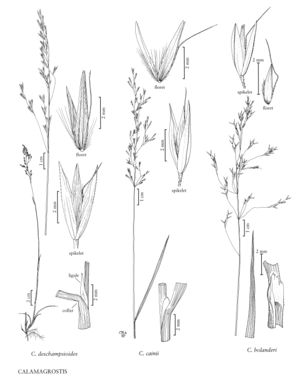Calamagrostis cainii
Plants sometimes with sterile culms; densely cespitose, without obvious rhizomes. Culms (30) 45-55 (60) cm, unbranched, smooth beneath the panicles; nodes 1-3. Sheaths and collars smooth; ligules 0.5-1.5 (2) mm, usually truncate, sometimes obtuse, entire; blades (5) 15-30 (39) cm long, (1) 2-3 (4) mm wide, flat, pale green, abaxial surfaces smooth, adaxial surfaces slightly scabrous, glabrous or sparsely hairy. Panicles (6) 8-12 (15) cm long, 1.5-3.5 (4) cm wide, open, often drooping, pale green and purple; branches (2) 2.5-4.5 (5) cm, smooth or slightly scabrous, spikelets usually confined to the distal 1/2-2/3. Spikelets 4-5 (6) mm; rachilla prolongations 1-2 mm, hairs 1.5-2 mm. Glumes rounded to slightly keeled, usually smooth, keels rarely finely scabrous distally, lateral-veins obscure, apices acute to acuminate; callus hairs 1.5-2 mm, 0.3-0.5 times as long as the lemmas, abundant; lemmas 3.5-4.5 mm, 0.5-1 mm shorter than the glumes; awns 4-5 (6) mm, attached from near the base to the lower 1/3 of the lemmas, exserted, stout and easily distinguished from the callus hairs, strongly bent; anthers (1) 2-2.5 mm. 2n = 28.
Discussion
Calamagrostis cainii grows on bouldery subtrates and in soil pockets, landslides, and disturbed sites, at 1200-2100 m. It has been found in only three locations: the slopes of Mount LeConte, Sevier County, Tennessee; and in North Carolina on Craggy Pinnacle, Buncombe County, and the summit of Mount Craig, Yancey County. The species is of conservation concern because of its limited distribution.
Selected References
None.
Lower Taxa
"decumbent" is not a number.
